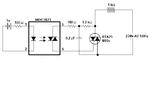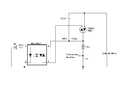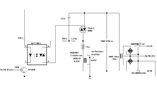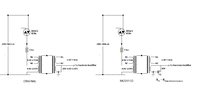My question today concerns how to position a current sense resistor in a 240V rms 50Hz mains powered resistive load dimmer circuit, under microcontroller control.
I have uploaded a schematic for such a conventional dimmer (dimmer_a), which I found on the Web (https://www.edaboard.com/threads/using-an-opto-triac-moc3020-to-control-a-mains-lamp.155997/ ) and have slightly modified.
My application is for passing 10 Watts of power through a resistive load. The load resistance starts at 1.0k and then rises over time to beyond 30.0k. So, I need to periodically measure the load resistance and adjust the triac firing angle to feed approximately 10 watts into the load.
At 5.76k and above, the power in the load will drop below 10W even with the triac continuously on. At that stage I will keep the triac continuously on. When the load resistance reaches 30k, power will be shut down and the heating cycle will be over.
I am thinking of measuring load resistance by measuring the average current through the load while passing a known rms voltage through it. I would like to use a low value current sense resistor in series with the load, rectify the voltage across it using a precision rectifier and then smooth its output with a RC integrator.
However, I cannot figure out a way to place this resistor in the conventional circuit dimmer_a. Therefore I have modified it, so that I can have a common ground between the mains part of the circuit and the 5v dc control power supply (and also a +5V to -5V dc power supply for the precision rectifier), and so I can place the current sense resistor referenced to this common ground.
This modified circuit is shown in uploaded schematic dimmer_modified.
Kindly examine the dimmer_modified schematic and check if this will work as I intend it to work. AND IF IT IS SAFE TO USE. I want to keep the Magic Smoke safely locked inside the components.
Incidentally, at load resistance values below 5.76k, I will measure the current through the load with the rms voltage through it set at 1/10th mains voltage (24V rms - @ phase angle of 159 degrees or 2.78 radians). At and above 5.76k I will use the full mains voltage.
Any better ideas to achieve the same purpose are very welcome!
I have uploaded a schematic for such a conventional dimmer (dimmer_a), which I found on the Web (https://www.edaboard.com/threads/using-an-opto-triac-moc3020-to-control-a-mains-lamp.155997/ ) and have slightly modified.
My application is for passing 10 Watts of power through a resistive load. The load resistance starts at 1.0k and then rises over time to beyond 30.0k. So, I need to periodically measure the load resistance and adjust the triac firing angle to feed approximately 10 watts into the load.
At 5.76k and above, the power in the load will drop below 10W even with the triac continuously on. At that stage I will keep the triac continuously on. When the load resistance reaches 30k, power will be shut down and the heating cycle will be over.
I am thinking of measuring load resistance by measuring the average current through the load while passing a known rms voltage through it. I would like to use a low value current sense resistor in series with the load, rectify the voltage across it using a precision rectifier and then smooth its output with a RC integrator.
However, I cannot figure out a way to place this resistor in the conventional circuit dimmer_a. Therefore I have modified it, so that I can have a common ground between the mains part of the circuit and the 5v dc control power supply (and also a +5V to -5V dc power supply for the precision rectifier), and so I can place the current sense resistor referenced to this common ground.
This modified circuit is shown in uploaded schematic dimmer_modified.
Kindly examine the dimmer_modified schematic and check if this will work as I intend it to work. AND IF IT IS SAFE TO USE. I want to keep the Magic Smoke safely locked inside the components.
Incidentally, at load resistance values below 5.76k, I will measure the current through the load with the rms voltage through it set at 1/10th mains voltage (24V rms - @ phase angle of 159 degrees or 2.78 radians). At and above 5.76k I will use the full mains voltage.
Any better ideas to achieve the same purpose are very welcome!
Attachments
Last edited:





